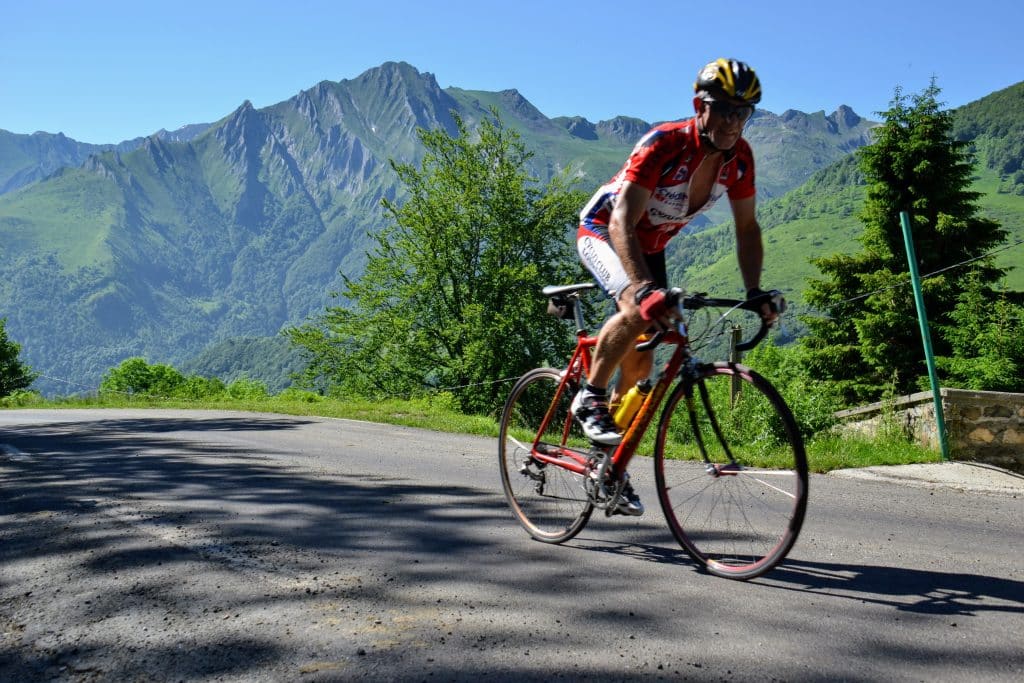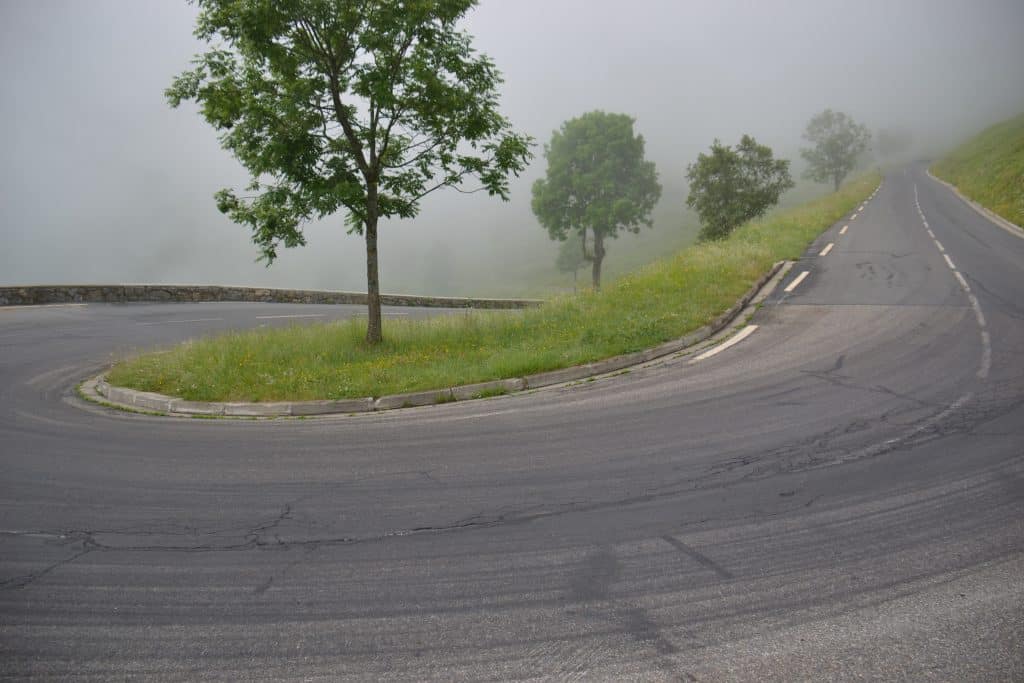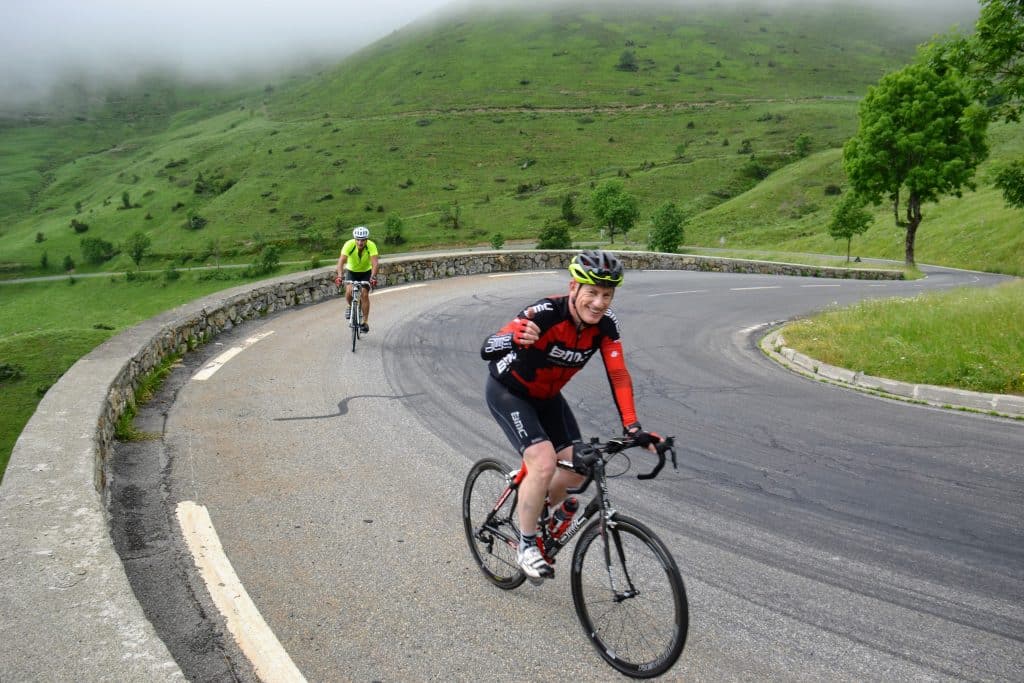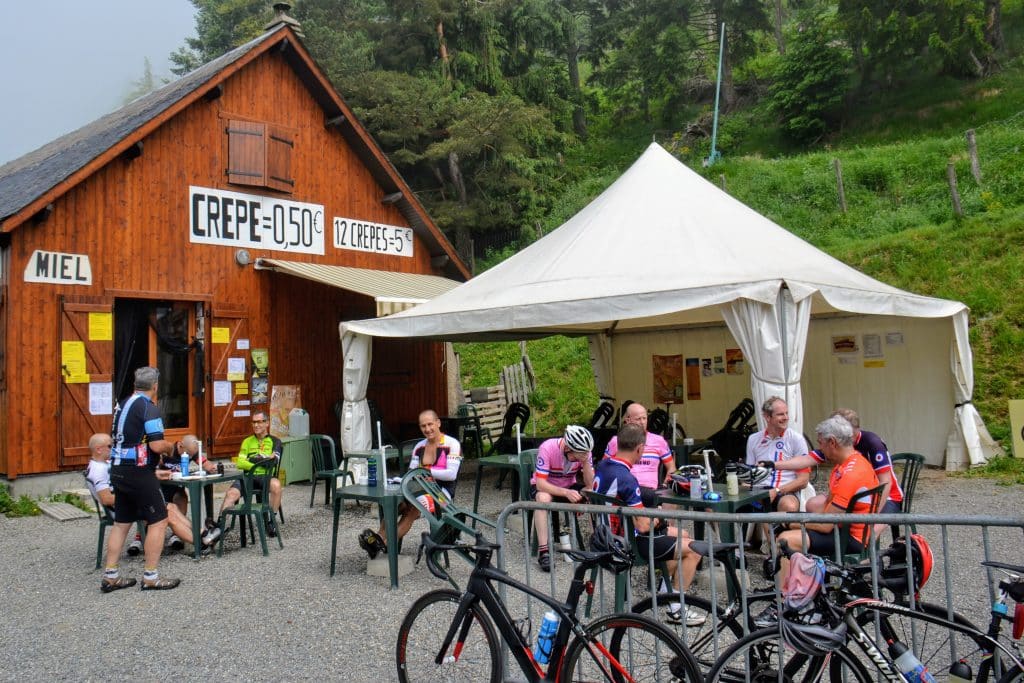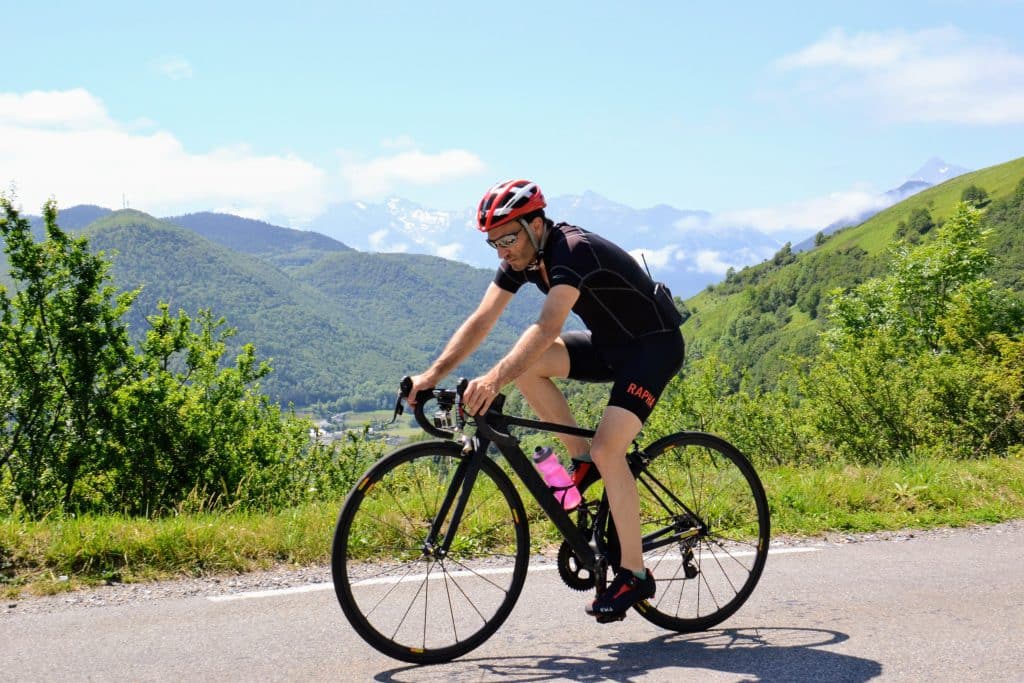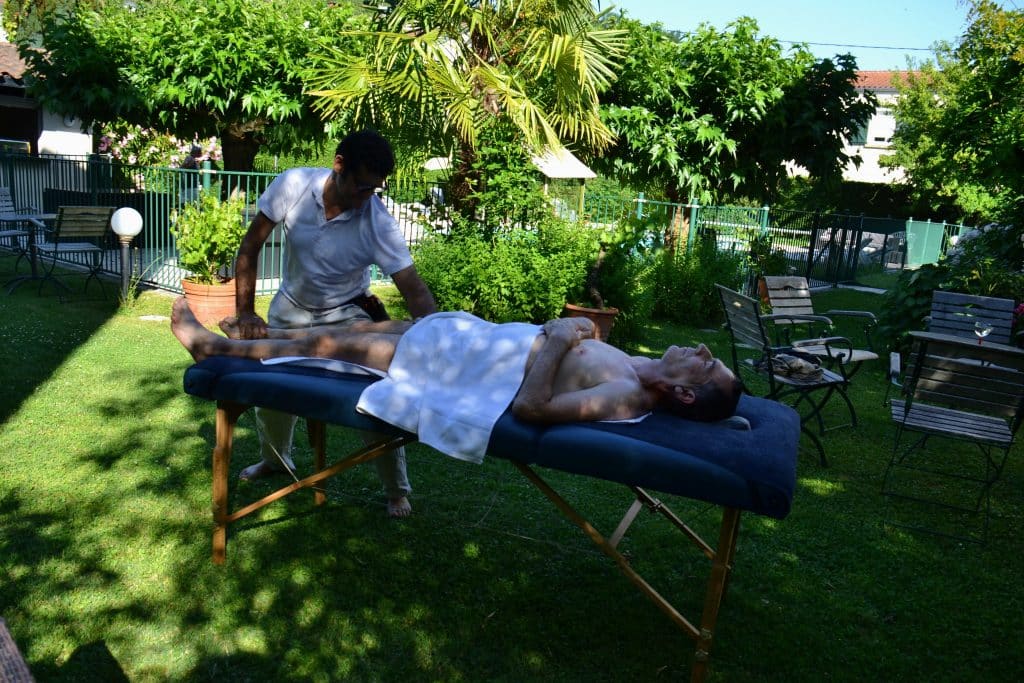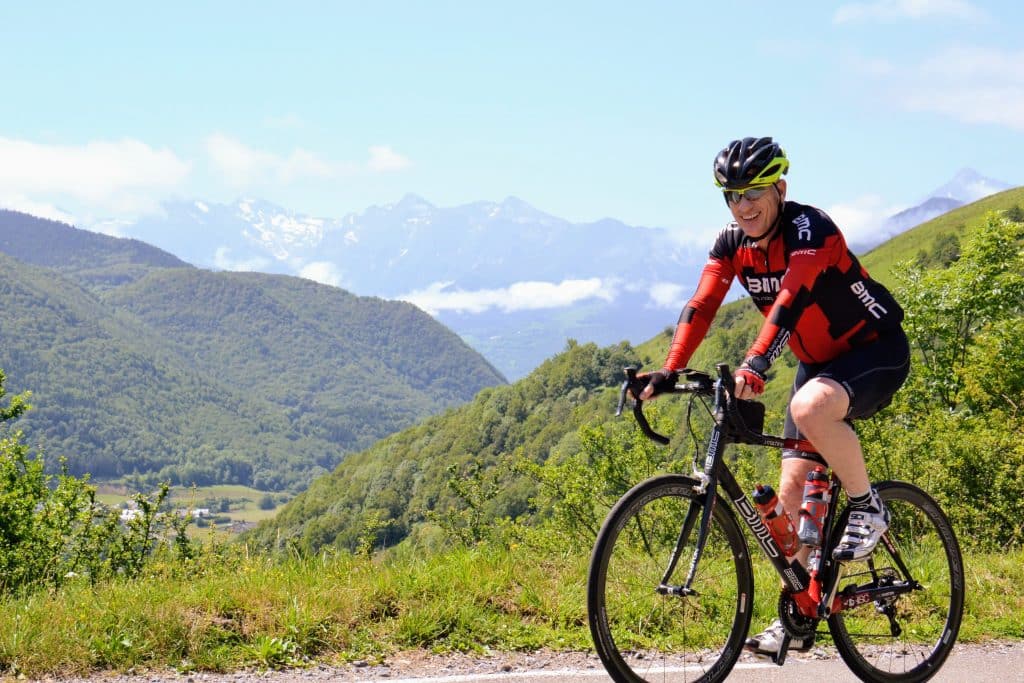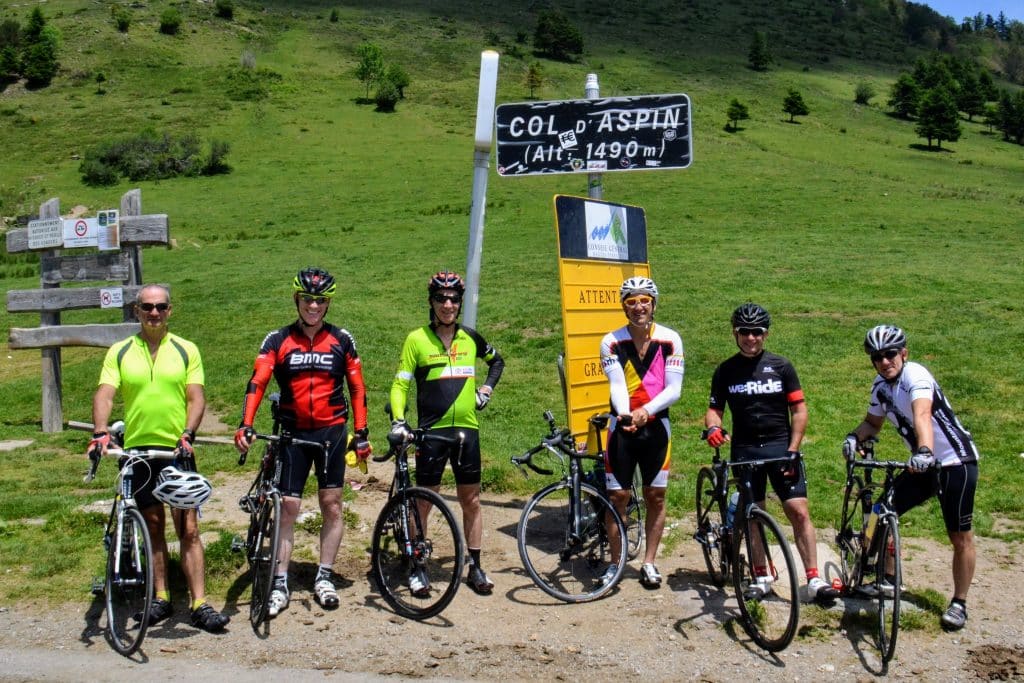2018 KOKOPELI TOUR de FRANCE EXPERIENCE
This fully supported Kokopeli tour will bring you up close and personal with some of cycling’s most famous summits and vistas. Not only will you conquer epic Pyrenean climbs, but you will also be provide 4 opportunities to experience the legendary Tour de France’s 105th edition. The course will traverse over fabled routes which had, only minutes before, absorbed the sweat of the greatest riders in the world. Over 7 days of cycling, you will ascend nearly 16,000 meters and cover 600 kilometers of French and Spanish countryside. First class accommodations have been selected in scenic towns located near Tour de France stage starts, where you can experience the colorful caravan that accompanies the Tour, and participate in the spectacle of millions of fans lining the route cheering on riders. This is truly a bucket-list experience that you will savor for the rest of your life.
Day 1 - Sunday 22.7.18 – Arrival in Barcelona – Transfer to Vielha – Assembly of the bikes
We will head out from Barcelona airport, driving towards the Aran Valley capital Vielha, where we will be staying for the next 3 days.
The Town
Barcelona hosted a flat stage of the Tour in 2009. The stage started in Girona and followed the Mediterranean coastline culminating in a bunch sprint finish in Barcelona, won by the Norwegian Thor Hushovd.
Val d’Aran is an isolated valley located on the French border with Catalonia, Spain. The Aran Valley region is considered to be the local capital of both on- and off-road cycling. The ski resorts around the valley are renowned worldwide and even the King of Spain himself comes here to spend his winter holidays.
Day 2 - Monday July 23.7.18 – Warming up
Vielha – Port de la Bonaigua – Llavorsí – Rafting – 70 km – 1600 Cumulative elevation gain
An enjoyable introductory day. Today we will climb one of the Pyrenees’ most famous peaks and end the day with an adrenaline-fueled river rafting excursion. After the rafting trip, you will be transported back to the hotel via the support van.
The Climb
Port de la Bonaigua – 23km – 4.8% – 1000m
The famous Bonaigua (good waters) mountain pass, which we will ride to today, was the first climb of Stage 9 of the 2016 TdF. Stage 9 was considered by many to be the Queen Stage of the 2016 TdF. It began in Vielha and ended with a mountain top finish more than 200 km away in Andorra. At the end of that day, under heavy rainfall, a victorious Tom Dumoulin was added to the Tour’s history pages. Less than a year later, he would become the first Dutchman to win a Grand Tour, winning the 2017 Giro d’Italia. This year he will try being the first Dutchman to win the Tour de France.
The Town
Vielha
The Tour de France has visited Spain many times in its history. Val d’Aran’s closeness to the border makes it a natural destination for hosting the Tour. This year the Tour passes through Spain again (for a short section). In 2016, the riders started their 9th course from Vielha, heading towards Andorra. Vielha is a popular tourist destination, the town is home to some fine old districts, including the Barri eth Cap dera Vila (the “top of the town”), where several fine 16C-17C mansions can be found. The cuisine specialty of the region is olha aranesa, a delicious casserole made from lamb, veal, bacon, black botifarra and vegetables.
Rafting
This fresh and exhilarating activity takes place on the breathtaking Noguera Pallaresa River, which means the experience does not only include rafting, but also the entire scenic surroundings – wild nature, lush vegetation, and awe-inspiring cliffs. Rafting here is rated amongst the best rafting rivers in Europe
Tuesday 24.7.18 – Welcome to France and to the Tour
Viella – Port de Balès- Luchon – Col du Portillon – 100 km – 2300m Elevation gain
We will head out riding towards the town Bagneres de Luchon the site of today´s TdF Stage 16 finish. Our route will take us north out of Spain around the Montanhes de Les Bossòst range. We wll then attack the feared Port de Bales from the north and descend into Luchon, where we will wait along with thousands of fans to view final kilometers of Stage 16. After the finish, you will have the option to ride back to Vielha via the Col du Portillon or catch a ride back to the hotel in the support van.
The Climbs
Port de Balès -19km – 6.2% – 1185m
Port de Bales has seen the Tour cross its col on 4 occasions in the last decade, including last year. In 2012, the Spaniard Alejandro Valverde won the Stage that follows the approach you will ride on this day. And two years earlier on a similar course also finishing in the Luchon, the Frenchman Thomas Voeckler was the victor.
Col du Portillon – 8.5km – 6.8% – 590m
Today Stage 16 of the TdF enters into the Pyrenees for the final and decisive week of the race. The Col du Portillon will be the final climb of the day before racing down to Luchon for the finale. This will be the 20th time that the Portillion has been used in the competition´s history. The col du Portillon serves as the border crossing between Spain and France, however, it is not easily noticed (no passport needed).
The Town
Bagneres de Luchon
Since 1947, this Pyrenean spa town has been host to a prolific number of Tour Stage starts and finishes. Luchon has been the start for 24 Stages and 30 times has served as finish line. Most recently the Tour ended here in 2016, and Chris Froome snatched the “maillot jaune” for the first time that year, “stealing it” by descending the Pereysourde at more than 100 km. This was one of the Tour´s most decisive moments, where with less than 10 km to the finish line, Froome managed to overtake and put time between his rivals.
Wednsday 25.7.18 – Feeling like a Tour de France Rider
63 km – 3000m Elevation gain – Luchon – Col de Peyresourde – Col d’Azet – Col de Portet
Today you will experience the exact same Tour route that the race will take just hours after you have conquered it. This is a short riding day, in fact the shortest normal stage of the last thirty years, however it is quite challenging, with 2 category 1 and 1 HC climbs and over 3000 meters of elevation gain. Stage 17 is expected to be one of the most decisive days of this year’s Tour, and after riding it, you will likely understand why. Following the final climb up to the Col de Portet (a new addition to the Tour that surpasses the Tourmalet in elevation), we will partially descend back down the mountain to a viewing location to watch the Tour riders attack and battle for the victory and enjoy some refreshments.
The Climbs
Col de Peyresourde 15km 7% 1100m
Although the Tour has only finished on this peak twice, it is an important mountain pass that has been included in the race almost every year since its first appearance in 1947. In 2017, Chris Froome lost the yellow jersey to the Italian Fabio Aru at the finish here. The Stage itself was won by the Frenchmen Romain Bardet, the best hope for a French Tour win this year. In 2012 the Spaniard Alejandro Valverde who won the Stage that finished atop the Peyragudes. Bradley Wiggins and Chris Froome finished 19 seconds behind. This mountain has a storied history, it also has a popular creperie that is a quick must to stop at after making the climb.
Col d’Azet – 8.5km 8.3% 615m
This is the 7th year since 1997 in which the Tour passes over Col d’Azet. Here, riders will encounter a short yet challenging climb, and from this summit they (and you) will be able to survey the approaching sufferfest of the Col de Portet across the valley. The Tour´s organizers try to vary the Pyrenean routes each year, however, due to the fact that mountains do not grow new peaks, many cols are frequently repeated over the years. Nevertheless, the col de Azet has managed to elude the organizers in the past and was only included in the tour for the first time in 1997.
Col de Portet – 17km – 8.3% – 1415m
This year the col de Portet will be introduced to the Tour. At 2,215 meters, it is the highest point of this years’ race and the highest of any Pyrenean summit finish in Tour history. It is steep and long, consistently over 10%. The climb is scheduled to be paved in time for the race, and when it happens, it will be the highest paved mountain pass in the French Pyrenees (surpassing the Col du Tourmalet). Currently the last few kilometers are unpaved gravel road, if the paving is not completed, it will be an even more epic challenge. After more than 3000 meters of climbing in a day, it should be this year´s most decisive Stage.
Thursday 26.7.18 – Famous Summits and Quick Finish
100 km – 2100m Elevation gain – Lourdes – Col du Soulor – Col d’Abisque – Pau
Heading out from our hotel, we will be riding towards two famous and arguably among the most beautiful summits in the Pyrenees, Col du Soulor and Col d’Aubisque. After summiting the Aubisque we will have a 55 km descent to the town of Pau where we will view the Stage 18 Sprint finish.
The Town
Lourdes
Lourdes is a Pyrenean town and Catholic Pilgrimage site attracting millions of visitors each year. The Sanctuary of Our Lady of Lourdes and the Château fort de Lourdes are the two major attractions. Over six million visitors come to Lourdes every year from all corners of the world seeking spiritual and physical healing. This constant stream of visitors has transformed the city into the second most important center of tourism in France and the third most important site of international Catholic pilgrimage after Rome and the Holy Land. The Tour passed many times through the town during the Pyrenean stages, last time being in 2016.
The Climbs
Col du Soulor – 19.5km – 5.2% – 1000m
With some 11-17% inclines, this is a climb definitely worthy of kicking the day off with. In 7 out of the 12 times the Tour passed through this summit, the stage ended in the town Pau, where today’s ride will end as well. The climb starts from a magical little village of Argeles-Gazost. Between the Soulor and Aubisque summits, is a spectacular narrow road ledge and tunnel hacked into rock perched half way up and along a 2000 meter sheer slope that rises up out of a beautiful valley. It’s a spectacular experience cycling along this one lane ledge looking 1000 meters up to the peak and then down 1000 meters to the valley. Every Tour de France enthusiast will recognize this place from television coverage.
Col d’Aubisque – 10km – 7.2% 500m
The Tour has crossed this peak dozens of times but only finished here 3 times in Race history. The last time the stage ended here it delivered a bitter-sweet drama. It was Michael Rasmussen who won the stage while wearing the Yellow Jersey, leading Alberto Contador by over 3 minutes. Celebrations lasted only until that evening when the Rabobank team announced that it would be dismissing the Danish rider for “violation of internal regulations”. This is when the Danish hope for a Yellow Jersey and a place in the history books was lost. This peak is also home to several colorful statues, with which every rider makes sure to take pictures with.
The Town
Pau (pronounced po)
It is said that this town´s name originates from an ancient word which translates to “mountainside”, obviously referring to the nearby Pyrenees. Its proximity to the Pyrenees is what has attracted the Tour de France to the town no less than 68 times in which it has either served as the start or finish location. The Tour last ended here in 2010, with the famous battle between Alberto Contador and Andy Schleck. The former won the Tour by over 30 seconds from the latter, however, two years afterwards, the title was stripped from the Spaniard (who denied any use of forbidden substances, claiming it was a result of tainted meat he had consumed), and given to Schleck. Today´s stage finishes here, and is mostly flat, which means the sprinters will have a good chance to shine.
Friday 27.7.18 – Tourmalet Summit and more
95 km – 270om Elevation gain – Lourdes – Col du Tourmalet – Col d’Aspin – Drive to Saint Girons
Today we will depart from Lourdes and head up the Vallée du Lavedan to climb the most famous summit in the Pyrenees, Col de Tourmalet, which will be passed by the riders a few hours later in the day. From the Tourmalet we will head to the col d’Aspin where we will watch the Tour battling the climb of the Aspin.
The Climbs
Col du Tourmalet – 18km – 9.2% 1400m
It is no surprise that many cycling product manufacturers use the name Tourmalet to add instant cachet to their products, it is steeped in tradition and one of the most storied climbs in all of cycling. No cycling tour photo album is complete without the iconic photo snapped on the summit of this instantly recognizable col. It has been ridden no less than 83 times since 1910, which was the first year the Pyrenees were added to the Tour´s itinerary. It is by far the most popular Tour de France mountain pass. Some famous riders who have stamped their authority on the race on its iconic slopes include Alberto Contador, Andy Schleck, Thibout Pinot, Rafal Majka, Eddy Merckx, and countless more. This is a painfully long climb with a 10% incline finish. When we pass here in the morning hours the place should already be packed with thousands of excited, beer-fueled fans that are waiting for the Tour, and will cheer us on, providing a small taste of the experience of TdF riders.
Col d’Aspin – 12.5km – 5% 650m
The Tour has passed over the Aspin over 50 times. Its proximity to Tourmalet and the valley towns makes it a must for almost any ride in the region. This year´s tour will pass here as well, before continuing to Tourmalet. We will wait here for the riders along with thousands of fans, with some beers and snacks, of course.
Saturday 28.7.17 – What´s good for the Tour is good for me
108 km – 3000m Elevation gain – Saint Girons – Col de Latrape – Col d’Agnes – Mur de Péguère – Saint Girons
Today we will retrace the most important portions of the route ridden on Stage 13 of the 2017 Tour. A gorgeous route with challenging mountain passes, at the end of which our clock will show 3000 meter elevation gain and over 100km.
The Town
Saint Girons
Saint Girons is a lovely town situated on the banks of the Salat river, whose location attracts riders worldwide. A riverside walk takes in Champ de Mars promenade, Pont Vieux bridge, Saint-Girons church and the Viscounts’ Palace and gardens. While in Saint Girons make a point of sampling a croustade, a delicious local puff pastry and with fruit! A colorful and flavorful market takes place every Saturday morning under the plane trees on the Champ de Mars. There is almost no amateur riding trip passing through the Pyrenees that does not stop here. The hotel in which we will stay caters to cyclists, and one can often meet a random pro rider here (last year alone we met members of the Orica team in this hotel, including Esteban Chaves). Post ride you can enjoy a relaxing swim or massage and a gourmet meal in the garden. The 100th edition of the Tour saw the start Stage 13 in Saint Girons, with Chris Froome wearing the Yellow Jersey at the beginning and end of the day. The White Jersey was worn by the Colombian rising star Nairo Quintana, whom is very likely to be one of Froome´s strongest opponents this year as well.
The Climbs
Col de Latrape – 5km – 7.5% – 400m
Relative to the icons of the Tour de France, this climb is not much more than a hill. However, we are certain your legs will feel it quite well. About halfway to the summit the climb kicks up to 10.6%. The pass was featured in the 2011 Tour de France when Sandy Casar was first to crest the hill. This climb has been included in the Tour only 7 times in the past, but is likely to be seen many more times in the future.
Col d’Agnes – 10km – 8% – 830m
This is another “poor” summit, in Tour de France terms, over which the riders only passed on their way to the finish line. Col d’Agnes is a 10 kilometres drag at 8% with steepest sections of more than 10% right at the base of the climb. Kilometre 8 is easiest with an average slope of ‘merely’ 4.9%. That’s a short relief though as the road continues in familiar fashion – steep. This climb has been included in the Tour 5 times in total. Among the riders whose names are associated with this spot is Sylvain Chavanel, record holder for number of participations in the Tour, and the late Marco Pantani.
Mur de Péguère – 10k – 7.9% – 730m
Mur de Péguère, is a formidable climb, packing a punch that will do some damage. The first five kilometres are fairly steady at around 5%, but then the suffering begins and the final 4 kilometers average 11% with the steepest sectors at 18%. This summit saw the Peloton pass through in 2017. The Frenchman, Warren Barguil won that stage in 2017, strengthening his hold over the title of King of the Mountain, which stayed with him until Paris, and proved himself being one of France´s future hopes for a Tour win.
Sunday 29.7.18 – Short ride/Back to Barcelona/Both
70 km – 1500m Elevation gain
Before returning to Barcelona to catch your flight home there will be an opportunity to get in one last short ride if desired. Other options may include exploring town, gift shopping, taking in a massage, or trying fishing on the Salat River.
WHAT´S INCLUDED:
- 7 nights at half board Hotels per person in double rooms
- Restaurants or picnic lunches
- Energy snacks, isotonic drinks, gels, and snacks
- Coffee kit
- Transport vehicle
- Guide vehicle with rescue and first aid kits
- Local professional guide
- Walkie talkies
- Personal transports when necessary
Price: From 1599€ per person
Final route may change due to weather, road conditions, local authorities´ instructions, and guide, and group decisions

